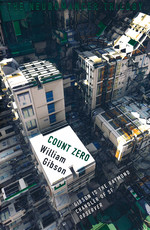
Sprawl (TPB) nr. 3: Count Zero (Gibson, William)
They set a Slamhound on Turner's trail in New Delhi, slotted it to his pheromones and the colour of his hair. When the Maas Biolabs and Hosaka zaibatsus fight it out for world domination, computer cowboys like Turner and Count Zero are just foot soldiers in the great game: useful but ultimately expendable. When Turner wakes up in Mexico - in a new body with a beautiful woman beside him - his corporate masters let him recuperate for a while, then reactivate his memory for a mission even more dangerous than the one that nearly killed him: the head designer from Maas Biolabs says he wants to defect to Hosaka, and it's Turner's job to deliver him safely. Count Zero is a rustbelt data-hustler totally unprepared for what comes his way when the designer's defection triggers war in cyberspace. With voodoo gods in the Net and angels in the software, he can only hope that the megacorps and the super-rich have their virtual hands too full to notice the amateur hacker with the black market kit trying desperately to stay alive . .
Udgivet af Gollancz
William Gibson
William Ford Gibson (born March 17, 1948) is an American-Canadian writer who has been called the "noir prophet" of the cyberpunk subgenre of science fiction. Gibson coined the term "cyberspace" in his short story "Burning Chrome" and later popularized the concept in his debut novel, Neuromancer (1984). In envisaging cyberspace, Gibson created an iconography for the information age before the ubiquity of the Internet in the 1990s. He is also credited with predicting the rise of reality television and with establishing the conceptual foundations for the rapid growth of virtual environments such as video games and the Web.
Having changed residence frequently with his family as a child, Gibson became a shy, ungainly teenager who often read science fiction. After spending his adolescence at a private boarding school in Arizona, Gibson dodged the draft during the Vietnam War by emigrating to Canada in 1968, where he became immersed in the counterculture and after settling in Vancouver eventually became a full-time writer. He retains dual citizenship. Gibson's early works are bleak, noir near-future stories about the effect of cybernetics and computer networks on humans – a "combination of lowlife and high tech". The short stories were published in popular science fiction magazines. The themes, settings and characters developed in these stories culminated in his first novel, Neuromancer, which garnered critical and commercial success, virtually initiating the cyberpunk literary genre.
Although much of Gibson's reputation has remained associated with Neuromancer, his work has continued to evolve. After expanding on Neuromancer with two more novels to complete the dystopic Sprawl trilogy, Gibson became an important author of another science fiction sub-genre—steampunk—with the 1990 alternate history novel The Difference Engine, written with Bruce Sterling. In the 1990s, he composed the Bridge trilogy of novels, which focused on sociological observations of near-future urban environments and late capitalism. His most recent novels—Pattern Recognition (2003) and Spook Country (2007)—are set in a contemporary world and have put his work onto mainstream bestseller lists for the first time.
Gibson is one of the best-known North American science fiction writers, fêted by The Guardian in 1999 as "probably the most important novelist of the past two decades". Gibson has written more than twenty short stories and nine critically acclaimed novels (one in collaboration), and has contributed articles to several major publications and collaborated extensively with performance artists, filmmakers and musicians. His thought has been cited as an influence on science fiction authors, design, academia, cyberculture, and technology.

